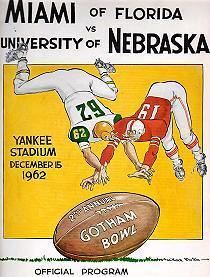 | ||
The Gotham Bowl was a post-season college football bowl game that was played in New York City, United States, in 1961 and 1962. The game was initially created as a fund raising attempt for the March of Dimes.
Contents
The game was not a success financially: the two games that were played both lost money as few fans were willing to sit through the cold December New York weather. Plus, as it was essentially a charity game, it had little financial capital on which it could survive.
1960
In what was supposed to be the game's inaugural year, the bowl hoped to invite Syracuse, but no invitation was extended when Syracuse announced immediately after its season ended that it would not accept any post-season offers. An Army-Air Force matchup fell through, so the bowl extended an offer to Oregon State. Holy Cross and Colorado turned down invitations after bowl officials mishandled the invitation process, leaving Oregon State with no opponent, forcing the bowl to postpone for another year.
1961
The following year, the Gotham Bowl managed to find two teams to play, Baylor and Utah State, for the game at the Polo Grounds. Baylor won, 24-9, in front of a sparse crowd of 15,123. (It would be the next-to-last college football game played at the Polo Grounds; Army would defeat Syracuse, 9-2, in front of 29,500 on September 29, 1962.)
1962
The 1962 edition of the Gotham Bowl, played in Yankee Stadium, was particularly tormented with poor planning and bad luck. The Miami Hurricanes were invited, but no opponent could be found. Finally, on December 4, 1962, just eleven days before the game, the Gotham Bowl invited Nebraska, which had just finished an 8-2 season. However, the day before the contest, the pilot of the Cornhuskers' team plane refused to leave the Lincoln airport until the bowl's check for expenditures cleared, which it did. (Miami made a similar demand and received their $30,000 expense check up front.)
In addition, the 1962-63 New York City newspaper strike began on December 8 and showed little sign of resolution, all but assuring that the Gotham Bowl would receive virtually no coverage in its own city. The contest was, however, aired on national television by ABC's Wide World of Sports.
The weather did not cooperate, either. A damp, 14-degree day limited the official attendance to just 6,166 (plus 5,000 tickets given away). Perhaps a few thousand stalwarts were actually in the stands at kickoff.
The game itself was a thriller: Nebraska edged Miami, 36-34, despite an MVP performance by Miami (and future professional) quarterback George Mira, who passed for 321 yards and a pair of touchdowns. (It was the Cornhuskers' first trip to the Big Apple in four decades, after beating Rutgers at the Polo Grounds 28-0 in 1920. Nebraska has not played a game in New York City proper since, although they have since played in the Kickoff Classic in suburban New Jersey.)
The poor attendance ensured the 1962 Gotham Bowl would be the last one played.
Pinstripe Bowl in 2010
On September 30, 2009, a new bowl game to be played in Yankee Stadium in 2010 was announced at a press conference in New York City. The game was set to feature the third- or fourth-place finisher in the Big East against the seventh-place team in the Big 12, according to BCS rules. If the Big 12 could not submit a team meeting the guidelines, Notre Dame agreed to step in. The game was to be played between Christmas Day and New Year's Day.
The name for the contest was revealed on March 9, 2010 as the Pinstripe Bowl. The leagues and the New York Yankees created a four-year agreement, running through the 2013 season. The payout to each team was set at about two million dollars.
